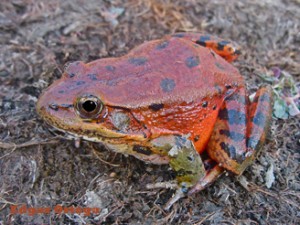06
Nov
Settlement Will Safeguard Endangered California Frog from Harmful Pesticides
(Beyond Pesticides, November 6, 2013) A federal district court approved a settlement Monday requiring the U.S. Fish and Wildlife Service to better protect California red-legged frogs from seven common pesticides known to be highly toxic to amphibians. The settlement gives the agency two years to prepare “biological opinions” under the Endangered Species Act (ESA) to analyze pesticide use in and near the frog’s aquatic and upland habitats.
 |
A 2006 legal settlement secured by the Center for Biological Diversity (CBD) required the U.S. Environmental Protection Agency (EPA) to assess pesticide impacts on red-legged frogs and to then formally consult with the Fish and Wildlife Service (FWS) under the ESA. The EPA’s assessments found that widespread use of pesticides is likely harming red-legged frogs and the court ordered temporary pesticide use restrictions that remain in effect today. EPA determined that 64 other pesticides are “likely to adversely affect” or “may affect” red-legged frogs. Despite the EPA’s findings, however, FWS and EPA failed to complete the required consultation, resulting in the litigation by CBD that culminated in Monday’s settlement.
The court order gives FWS two years to complete biological opinions for seven pesticides: glyphosate, malathion, simazine, pendimethalin, permethrin, methomyl and myclobutanil. This consultation process could lead to permanent restrictions on some of the most harmful pesticide uses. Many of the pesticides are endocrine disruptors that have been observed to interfere with natural hormone functions, damage reproductive function and offspring, and cause developmental, neurological, and immune problems in wildlife and humans. While not listed in this action, atrazine for instance, causes complete sex reversal in frogs, even in low concentrations. Similarly, a recent study found levels of pesticide contamination from agricultural drift in Pacific Tree frogs in remote mountain areas in California, including national parks. According to this study, chemical concentrations are often higher in the frog tissue than the environment.
“We’re hopeful the analysis required by this agreement will stop the use of harmful pesticide in the red-legged frog’s most vulnerable habitats and open the door to its recovery,” said Justin Augustine, an attorney at the Center for Biological Diversity. “It’s long overdue.”
ESA requires EPA to consult with federal wildlife agencies to ensure that the agency avoids authorizing pesticide uses that jeopardize endangered species. If FWS determines EPA registration of a pesticide is likely to harm listed species, it may specify use restrictions to mitigate adverse effects. Conservation groups have filed a series of lawsuits over the years attempting to force such consultations, which have resulted in restrictions on pesticide use near endangered species habitats, particularly for the endangered salmon and steelhead. In a similar lawsuit in 2002, fishermen, environmental groups and other salmon advocates, with legal representation from Earthjustice, obtained a federal court order declaring that EPA violated ESA by failing to consult on the impacts that certain pesticides have on salmon and steelhead in the Pacific Northwest and California. In 2007, salmon advocates filed a second lawsuit and entered into a settlement agreement that establishes a schedule for issuing the required biological opinions. Thus far, several biological opinions have been published with respect to salmon and steelhead, calling for the restriction of certain pesticides near vulnerable habitat.
In June 2013, CBD and Pesticide Action Network filed an amended complaint in their ongoing efforts to protect the nation’s most vulnerable wildlife from toxic pesticides. The lawsuit seeks to compel EPA to evaluate the impacts of dozens of pesticides known to be toxic to more than 100 endangered and threatened species, including Florida panthers, California condors, piping plovers, black-footed ferrets, arroyo toads, Indiana bats and Alabama sturgeon. Documents from FWS and EPA, as well as peer-reviewed scientific studies, indicate that these species are harmed by pesticides.
A committee of the National Academy of Sciences’ Research Council (NRC) issued a report this year that outlined steps to improve regulatory problems associated with pesticides that harm endangered and threatened species. The report suggests the need to overhaul EPA’s deeply flawed pesticide approval process and recommends better coordination and agreement between the agencies that would facilitate an integrated approach to examining risks to listed species and their habitats. EPA, FWS, and other agencies plan to roll out new guidelines under which they will conduct consultations.
Amphibians are declining at alarming rates around the globe and scientists believe pesticides may be partly to blame. More than 200 million pounds of pesticides are applied each year in California. Most of these chemicals have not been evaluated for impacts on wildlife, as required under ESA. Agricultural pesticides introduced into wetlands, ponds and streams are particularly harmful to frogs, whose permeable skins readily absorb toxins from their aquatic environments. Once abundant throughout California, California red-legged frogs were listed as threatened under ESA in 1996. Their numbers have declined more than 90 percent; the species is no longer found in 70 percent of its former range. The most severe declines have been observed in the Sierra Nevada Mountains east of California’s central valley, where frogs are exposed to pesticides from the intensively farmed San Joaquin valley. The pesticides of concern for red-legged frogs include several controversial chemicals that public health, sustainable-farming, farmworker and conservation groups advocate banning due to unacceptable hazards to humans and wildlife.
All unattributed positions and opinions in this piece are those of Beyond Pesticides
Source: Center for Biological Diversity
Image: Save the Frogs










